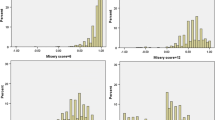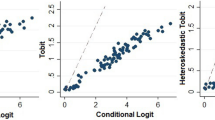Abstract
Purpose
To derive a value set from Uruguayan general population using the EQ-5D-5L questionnaire and report population norms.
Methods
General population individuals were randomly assigned to value 10 health states using composite time trade off and 7 pairs of health states through discrete choice experiments. A stratified sampling with quotas by location, gender, age and socio-economic status was used to respect the Uruguayan population structure. Trained interviewers conducted face-to-face interviews. The EuroQol valuation technology was used to administer the protocol as well as to collect the data. OLS and maximum likelihood robust regression models with or without interactions were tested.
Results
We included 794 respondents between 20 and 83 years. Their characteristics were broadly similar to the Uruguayan population. The main effects robust model was chosen to derive social values. Values ranged from −0.264 to 1. States with a misery index = 6 had a mean predicted value of 0.965. When comparing the Uruguayan population with the Argentinian EQ-5D-5L crosswalk value set, the prediction for states which differed from full health only in having one of the dimensions at level 2 were about 0.05 higher in Uruguay. The mean index value, using the selected Uruguayan EQ-5D-5L value set, for the general population in Uruguay was 0.895. In general, older people had worse values and males had slightly better values than females.
Conclusion
We derived the EQ-5D-5L Uruguayan value set, the first in Latin America. These results will help inform decision-making using economic evaluations for resource allocation decisions.
Similar content being viewed by others
References
Hawthorne, G., Richardson, J., & Day, N. A. (2001). A comparison of the Assessment of Quality of Life (AQoL) with four other generic utility instruments. Annals of Medicine, 33(5), 358–370.
Brauer, C. A., Rosen, A. B., Greenberg, D., & Neumann, P. J. (2006). Trends in the measurement of health utilities in published cost-utility analyses. Value Health, 9(4), 213–218.
Guide to the methods of technology appraisal 2013. (2013). Process and methods guides. National Institute for Heatlh and Care Excellence (NICE): UK.
Szende, A., Oppe, M., & Devlin, N. (2007). EQ-5D value sets: Inventory, comparative review and user guide (Vol. 2). Dordrecht: Springer.
Augustovski, F. A., Irazola, V. E., Velazquez, A. P., Gibbons, L., & Craig, B. M. (2009). Argentine valuation of the EQ-5D health states. Value Health, 12(4), 587–596.
Zarate, V., Kind, P., Valenzuela, P., Vignau, A., Olivares-Tirado, P., & Munoz, A. (2011). Social valuation of EQ-5D health states: The Chilean case. Value Health, 14(8), 1135–1141.
Viegas Andrade, M., Noronha, K., Kind, P., Maia, A. C., Miranda de Menezes, R., De Barros Reis, C., et al. (2013). Societal preferences for EQ-5D health states from a Brazilian population survey. Value in Health Regional Issues, 2(3), 405–412.
EuroQol, G. (1990). EuroQol–a new facility for the measurement of health-related quality of life. Health Policy, 16(3), 199–208.
Herdman, M., Gudex, C., Lloyd, A., Janssen, M., Kind, P., Parkin, D., et al. (2011). Development and preliminary testing of the new five-level version of EQ-5D (EQ-5D-5L). Quality of Life Research, 20(10), 1727–1736.
Pattanaphesaj, J., & Thavorncharoensap, M. (2015). Measurement properties of the EQ-5D-5L compared to EQ-5D-3L in the Thai diabetes patients. Health Qual Life Outcomes, 13(1), 14.
Golicki, D., Niewada, M., Buczek, J., Karlinska, A., Kobayashi, A., Janssen, M. F., & Pickard, A. S. (2015). Validity of EQ-5D-5L in stroke. Quality of Life Research, 24(4), 845–850.
Conner-Spady, B. L., Marshall, D. A., Bohm, E., Dunbar, M. J., Loucks, L., Khudairy, A. A., & Noseworthy, T. W. (2015). Reliability and validity of the EQ-5D-5L compared to the EQ-5D-3L in patients with osteoarthritis referred for hip and knee replacement. Quality of Life Research, 24(7), 1775–1784.
Greene, M. E., Rader, K. A., Garellick, G., Malchau, H., Freiberg, A. A., & Rolfson, O. (2014). The EQ-5D-5L Improves on the EQ-5D-3L for health-related quality-of-life assessment in patients undergoing total hip arthroplasty. Clinical Orthopaedics and Related Research. doi:10.1007/s11999-014-4091-y.
Oppe, M., Devlin, N. J., van Hout, B., Krabbe, P. F., & de Charro, F. (2014). A program of methodological research to arrive at the new international EQ-5D-5L valuation protocol. Value Health, 17(4), 445–453.
EuroQol Valuation Technology. (2011). Retrieved January, 2015, from https://www.valuationstudy.org.
Censo. (2011). Retrieved September 2014, from http://www.ine.gub.uy/censos2011/index.html.
Modificación de la integración de la comisión asesora del Formulario Terapéutico Nacional. (2010). Decreto N 04/010 (2010th ed.). Montevideo: Presidencia República Oriental del Uruguay.
Fondo Nacional de Recursos. Retrieved January 2015, from http://www.fnr.gub.uy.
Devlin, N. J., & Krabbe, P. F. (2013). The development of new research methods for the valuation of EQ-5D-5L. The European Journal of Health Economics, 14(Suppl 1), S1–S3.
Dolan, P. (1997). Modeling valuations for EuroQol health states. Medical Care, 35(11), 1095–1108.
Tilling, C., Devlin, N., Tsuchiya, A., & Buckingham, K. (2010). Protocols for time tradeoff valuations of health states worse than dead: A literature review. Medical Decision Making, 30(5), 610–619.
Lamers, L. M. (2007). The transformation of utilities for health states worse than death: Consequences for the estimation of EQ-5D value sets. Medical Care, 45(3), 238–244.
Augustovski, F., Rey-Ares, L., Irazola, V., Oppe, M., & Devlin, N. J. (2013). Lead versus lag-time trade-off variants: Does it make any difference? The European Journal of Health Economics, 14(Suppl 1), S25–S31.
Janssen, B. M., Oppe, M., Versteegh, M. M., & Stolk, E. A. (2013). Introducing the composite time trade-off: A test of feasibility and face validity. European Journal of Health Economics, 14(Suppl 1), S5–S13.
Krabbe, P. F., Devlin, N. J., Stolk, E. A., Shah, K. K., Oppe, M., van Hout, B., et al. (2014). Multinational evidence of the applicability and robustness of discrete choice modeling for deriving EQ-5D-5L health-state values. Medical Care, 52(11), 935–943.
Ramos-Goni, J. M., Rivero-Arias, O., Errea, M., Stolk, E. A., Herdman, M., & Cabases, J. M. (2013). Dealing with the health state ‘dead’ when using discrete choice experiments to obtain values for EQ-5D-5L heath states. European Journal of Health Economics, 14(Suppl 1), S33–S42.
Ramos-Goni, J. M., Pinto-Prades, J. L., Oppe, M., Cabases, J. M., Serrano-Aguilar, P., & Rivero-Arias, O. (2014). Valuation and modeling of EQ-5D-5L health states using a hybrid approach. Medical Care. doi:10.1097/MLR.0000000000000283.
Lee, S. Y., Stucky, B. D., Lee, J. Y., Rozier, R. G., & Bender, D. E. (2010). Short assessment of health literacy-Spanish and English: A comparable test of health literacy for Spanish and English speakers. Health Services Research, 45(4), 1105–1120.
Selden, C. R., Zorn, M., Ratzan, S. C., & Parker, R. M. (2000). Health literacy, current bibliographies in medicine. Bethesda, MD: National Institutes of Health.
Huber, P. J. (1964). Robust estimation of a location parameter. The Annals of Mathematical Statistics, 35(1), 73–101.
Hamilton, L. (1991). srd1: How robust is robust regression? Stata Technical Bulletin Reprints, 1, 169–175.
EQ-5D-5L Crosswalk value sets. Retrieved January 2015, from http://www.euroqol.org/about-eq-5d/valuation-of-eq-5d/eq-5d-5l-value-sets.html.
van Hout, B., Janssen, M. F., Feng, Y. S., Kohlmann, T., Busschbach, J., Golicki, D., et al. (2012). Interim scoring for the EQ-5D-5L: Mapping the EQ-5D-5L to EQ-5D-3L value sets. Value Health, 15(5), 708–715.
Szende, A., Janssen, B. M., & Cabasés, J. M. (2014). Self-reported population health: An international perspective based on EQ-5D. Dordrecht, Heidelberg, New York, London: Springer.
Acknowledgments
Special thanks to Arnd Jan Prause for the support and Elka Pérez and Gastón Díaz from “Equipos Mori” for their great work and commitment.
Author information
Authors and Affiliations
Corresponding author
Ethics declarations
Conflict of interest
All authors declare that they have no conflict of interest.
Funding
This Project was funded by Uruguay’s National Resources Fund (Fondo Nacional de Recursos) (ID No 19/12) and the EuroQol Research Foundation (ID: EQ 2013070).
Ethical approval
All procedures performed in studies involving human participants were in accordance with the ethical standards of the institutional and/or national research committee and with the 1964 Helsinki declaration and its later amendments or comparable ethical standards.
Electronic supplementary material
Below is the link to the electronic supplementary material.
Technical Appendix
Technical Appendix
In this manuscript, the value set for Uruguay has been presented (see Table 3). This appendix describes how to obtain the utility value for a specific health state. Notice that the model coefficients should be interpreted as the disutility of moving from having no problems in that particular domain (level 1) to the specific level of response of each domain.
Given the profile of a specific health state, LMOLSCLUALPDLAD, and given the final model and coefficients to derive them, the formula to obtain the utility value for each health state is as follow:
U(LMOLSCLUALPDLAD) = 1 − MO(LMO) − SC(LSC) − UA(LUA) − PD(LPD) − AD(LAD)—Deviation from full health.
Where U(LMOLSCLUALPDLAD) denotes the utility for the state LMOLSCLUALPDLAD, LMO denotes the response level on mobility domain, MO(LMO) denotes the coefficient of the level LMO on mobility domain (and the same for rest of domains), and Deviation from full health is the model constant. When the level of a given domain is no problems (1), the coefficient of that domain is 0. As there is no movement from no problems, no disutility is associated.
Example 1
U(25413) = 1 − MO2 – SC5 − UA4 − PD1 (=0) − AD3-Deviation from full health = 1 − 0.0140 − 0.2734 − 0.1183 − 0 − 0.0435 − 0.0126 = 0.5382
Example 2
U(31412) = 1 − MO3 − SC1 (=0) − UA4 − PD1 (=0) − AD2-Deviation from full health = 1 − 0.0322 − 0 − 0.1183 − 0 − 0.0095 − 0.0126 = 0.8274
Example 3
U(11111) = 1 − MO1 (=0) − 0 (SC1) − UA1 (=0) − PD1 (=0) − AD1 (=0) = 1 (Notice that 11111 represents full health, so the deviation from full health is not applicable here).
Stata code
-
//This code calculates the utility values for a given data set
-
//The variable representing mobility domain has to be named MO, SC for self-care, UA for usual activities, PD for pain/discomfort and AD for anxiety/depression
-
gen Utility = 1.
-
recast double Utility
//MO
-
replace Utility = Utility − 0.0140 if MO == 2
-
replace Utility = Utility − 0.0322 if MO == 3
-
replace Utility = Utility − 0.1077 if MO == 4
-
replace Utility = Utility − 0.2987 if MO == 5
//SC
-
replace Utility = Utility − 0.0256 if SC == 2
-
replace Utility = Utility − 0.0609 if SC == 3
-
replace Utility = Utility − 0.1169 if SC == 4
-
replace Utility = Utility − 0.2734 if SC == 5
//UA
-
replace Utility = Utility − 0.0424 if UA == 2
-
replace Utility = Utility − 0.0455 if UA == 3
-
replace Utility = Utility − 0.1183 if UA == 4
-
replace Utility = Utility − 0.2315 if UA == 5
//PD
-
replace Utility = Utility − 0.0171 if PD == 2
-
replace Utility = Utility − 0.0607 if PD == 3
-
replace Utility = Utility − 0.1870 if PD == 4
-
replace Utility = Utility − 0.2705 if PD == 5
//AD
-
replace Utility = Utility − 0.0095 if AD == 2
-
replace Utility = Utility − 0.0435 if AD == 3
-
replace Utility = Utility − 0.1043 if AD == 4
-
replace Utility = Utility − 0.1771 if AD == 5
//Deviation from full health
-
replace Utility = Utility − 0.0126 if (MO ! = 1 | SC ! = 1 | UA ! = 1 | PD ! = 1 | AD ! = 1)
Rights and permissions
About this article
Cite this article
Augustovski, F., Rey-Ares, L., Irazola, V. et al. An EQ-5D-5L value set based on Uruguayan population preferences. Qual Life Res 25, 323–333 (2016). https://doi.org/10.1007/s11136-015-1086-4
Accepted:
Published:
Issue Date:
DOI: https://doi.org/10.1007/s11136-015-1086-4




